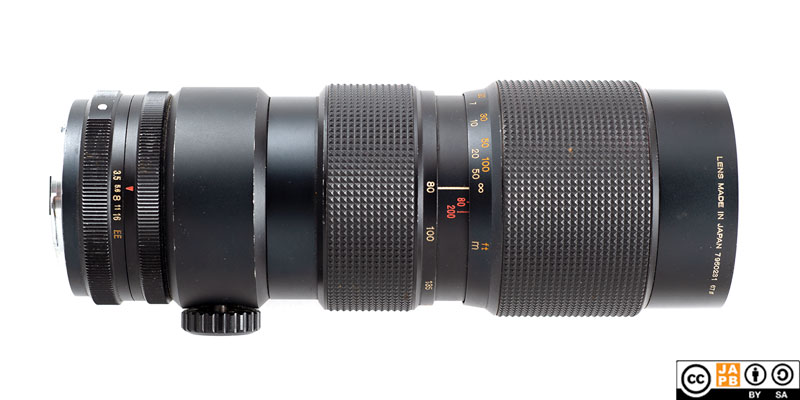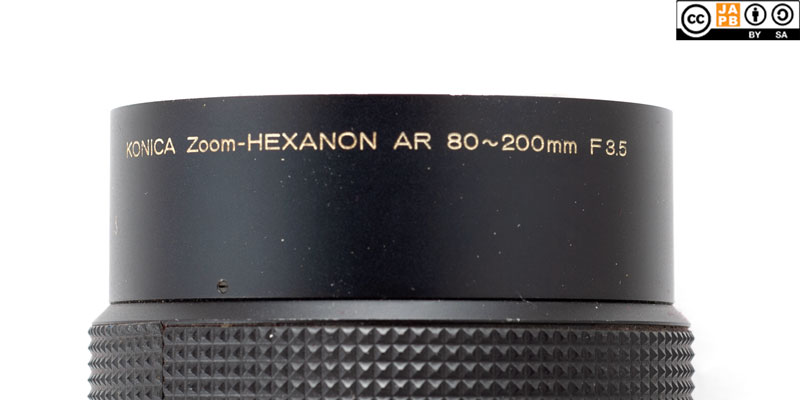Pekka Buttler, 11/2023

Specifications
The table below summarizes the lens’ key specifications:
| Brand: | Konica | Lens name | Zoom HEXANON AR 80~200 mm F 3.5 |
| Focal length(s) 1 | 80-200 mm | Angle-of-view 2 | 30–12 ° |
| Maximum Aperture | f/3.5 | In Production | 1968–1975 |
| Lens mount | Konica AR | Subfamily (if applicable) | –– |
| Length 3 | 204 mm | Diameter 4 | 74,9 mm |
| Filter ring diameter | 67 mm | Weight | 1157 grams |
| Lens element count | 17 | Lens group count | 10 |
| Aperture blades (S/R/C) 5 | 6 S | Focus throw | 220 ° |
| Minimum focusing distance | 1,8 m | Maximum magnification | 1:7 |
| Has manual aperture ring | YES | Has Manual focus ring | YES |
| Aperture mechanism type | Automatic | Aperture click stops 6 | 3.5•5.6•8•11•16 |
Further notes:
• This lens was a true marvel. On its introduction in 1968 it was the fastest 70/80–200 mm telephoto zoom manufactured by a major brand (Nikon’s and Canon’s contemporary offerings peaked at f/4.5
• Astonishingly it stayed that way until 1976 when Pentax released a similarly spec’ed tele zoom (the Pentax 85-210 mm f/3.5, which however was quickly discontinued.
• To indicate how revolutionary this lens was: Professional-grade Tele zooms with a focal length range of ≈ 70/80–200 and a maximum aperture of f/3.5 or faster entered the lineups of Konica’s competitors only in
– 1982 (Nikon Ai-S Zoom-Nikkor*ED 80-200mm f2.8),
– 1987 (Minolta AF 80-200mm F2.8 APO),
– 1989 (Canon EF 80-200mm f/2.8L),
– 1994 (SMC Pentax-FA* 80-200mm F2.8 ED[IF])
• The lens is a two-ring zoom, with the rear ring controlling zoom (markings at 80, 100, 135, 170 and 200) and the front ring controlling focusing.
• While the lens does not change shape on zooming (internal zoom) it changes length on focusing. Moreover, the entire front-end of the lens (including filter thread) rotates on focusing.
• Importantly, the lens is very near parfocal (parfocal enough that you would not have noticed the difference before high-res digital sensors).
• The lens comes with a non-detachable tripod collar that rotates 360 °.
• Some sources say the lens was introduced 1966, others give the year 1968. I’ve written this data sheet based on the more conservative estimate of 1968.
• Konica Lens names are usually printed on a ring inside the lens’ barrel, but this is one of those lenses where the lens name is printed on the outside of the barrel (to maximise the size of the front element).

History of Konica AR lenses
Konica is one of those names that will not ring any bells to those who’ve only recently started photographing, but for many years Konica was one of the ‘Great Japanese camera companies’.
After a short-lived and only moderately successful line of SLR cameras known as the Konica F-line (1960-1965), Konica hit pay dirt with the introduction of the Konica Auto-Reflex in 1965 and its new, Konica AR mount. The Auto-Reflex was at the time the first affordable system camera with integrated auto-exposure (albeit the exposure metering was not yet TTL). The Auto-Reflex was followed by a two lines of successful cameras – the more ambitious Autoreflex T-line and the more pedestrian Autoreflex A-line – before Konica (along with the rest of Japanese camera companies) stepped up the automation of their SLR cameras with the 1-series (FS-1, FC-1, FP-1, and FT-1).
But while Konica had often been at the forefront of automation (first shutter priority auto-exposure system, first SLR with integrated winder), Konica’s star had been waning, and Konica decided to not compete against the likes of Minolta, Nikon, Canon, and Pentax in autofocus technology. Instead Konica withdrew from SLR and SLR lens manufacture and focused on compacts and other optoelectronics. Two decades later Konica merged with Minolta to form KonicaMinolta, which subsequently sold its camera business to Sony. So, after a fashion, the DNA of Konica’s camera business lives on in Sony’s camera division.
Relevantly, the Konica AR mount had a relatively good and long (1965–1987) run, and stayed remarkably unchanged throughout. Hence, while Konica changed the design of their AR lenses during those years – moving towards lighter constructions, rubber focus rings, and a more modern look (for more detail, look here) – all AR lenses are physically entirely compatible with all AR-mount bodies.´
Versions
There are altogether five cosmetically different versions of this lens. While the differences between versions are likely to have had some effect on dimensions and weight, it would seem the optical recipe stayed the same throughout.
• Version 1: Broad chrome ring between aperture ring and tripod collar, all-metal control rings, yellow EE, No AE Lock, “KONICA HEXANON ZOOM”
• Version 2: Narrow chrome ring between aperture ring and tripod collar, all-metal control rings, yellow EE, No AE Lock, “KONICA Zoom-HEXANON”
• Version 3: chrome ring, rubberized control rings, yellow EE, AE Lock, “KONICA Zoom-HEXANON”
• Version 4: all-black, rubberized control rings, yellow EE, AE Lock, “KONICA Zoom-HEXANON” [pictured sample]
• Version 5: all-black, rubberized control rings, green AE, AE Lock, “KONICA Zoom-HEXANON”
These versions are somewhat hard to date, but all indications are that versions 1 & 2 stem from the 1968-1970 period, and versions 4 & 5 can be dated to 1972–1975. Version 3 seems to be extremely rare (I’ve yet to see one in the wild), but it is mentioned in several sources.
Adapting
n.B! The following applies to all Konica AR mount lenses.
This lens cannot be used natively on any current SLR or dSLRs. To use it in its native environment, you will need a Konica AR-mount film body.
Thanks to being a fully manual lens (manual aperture, manual focus), the lens can be adapted to all mirrorless cameras using a suitable adapter. Moreover, Konica AR lenses are so uncomplicated that a simple ‘dumb adapter’ will do the job perfectly. However, due to Konica AR lenses not being among the most numerously manufactured, special adapters (helicoid adapters, tilt/shift adapters) are not easy to come by and speed boosters are currently unavailable.
Using Konica AR lenses on dSLRs is possible, but difficult. Due to the exceptionally short flange focal distance of the Konica AR mount (at 40,5 mm, a lot shorter than that of any full-frame dSLR mount), any adapter will necessitate some optics to achieve anything near infinity focus.
Footnotes
- Focal length is (unless stated otherwise) given in absolute terms, and not in Full-frame equivalent. For an understanding of whether the lens is wide/tele, see ‘Angle-of-view’. ↩︎
- Picture angle is given in degrees (based on manufacturers’ specs) and concerns the diagonal picture angle. Rule of thumb:
> 90 ° ==> Ultra-wide-angle
70–90 ° ==> Wide-angle
50–70 ° ==> Moderate wide-angle
40–50 ° ==> ‘Standard’ or ‘normal’ lens
20–40 ° ==> Short tele lens
10-20 ° ==> Tele lens
5-10 ° ==> Long tele lens
< 5 ° ==> Ultra-tele lens ↩︎ - Length is given from the mount flange to the front of lens at infinity. ↩︎
- Diameter excludes protrusions such as rabbit ears or stop-down levers. ↩︎
- S=straight; R=rounded; C=(almost)circular at all apertures. ↩︎
- Diameter excludes protrusions such as rabbit ears or stop-down levers. ↩︎